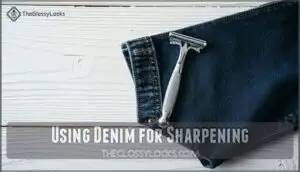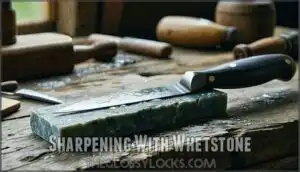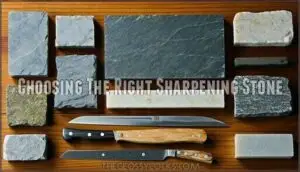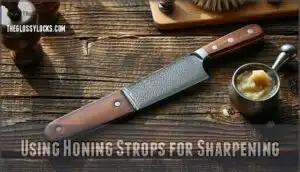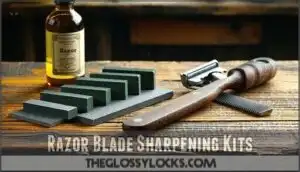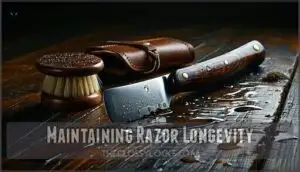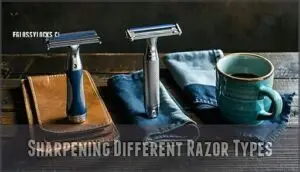This site is supported by our readers. We may earn a commission, at no cost to you, if you purchase through links.

Natural ways to sharpen razor blades include stropping against old denim jeans, which polishes the edge through gentle friction.
A leather belt or strop works even better for straight razors.
Clean your blade first with soap and water, then run it backwards along the denim about 10-15 times.
For safety razors, try a sharpening stone with light pressure at the correct angle.
Mineral oil helps prevent rust between uses.
Always dry blades thoroughly after cleaning.
These methods won’t work miracles on completely dull blades, but they’ll squeeze extra shaves from decent ones.
The secret lies in understanding which technique works best for your specific razor type.
Table Of Contents
- Key Takeaways
- Razor Preparation Methods
- Natural Sharpening Techniques
- Sharpening Tool Options
- Maintaining Razor Longevity
- Sharpening Different Razor Types
- Frequently Asked Questions (FAQs)
- How can I sharpen my razor at home?
- How to sharpen a razor blade without a sharpener?
- Does baby oil keep razor blades sharp?
- What can I use to sharpen my straight razor?
- How often should you sharpen razor blades?
- Can electric razor blades be sharpened naturally?
- What signs indicate a razor needs sharpening?
- Are homemade sharpening solutions safe to use?
- Which natural materials work best for sharpening?
- Conclusion
Key Takeaways
- You can extend your razor’s life using common household items – stropping against old denim jeans 10-15 times backwards works effectively, while leather belts or strops provide even better results for straight razors.
- Proper preparation is essential before sharpening – you’ll need to clean your razor thoroughly with soap and hot water, disinfect with rubbing alcohol, and dry completely to prevent rust and ensure sharpening techniques work effectively.
- Different razor types require specific sharpening approaches – single-edge razors respond best to stropping and whetstone techniques, while multi-blade cartridges work better with gentle denim stropping across all blades simultaneously.
- Maintenance extends sharpening results significantly – you should apply mineral oil after cleaning to prevent rust, store razors in dry locations away from humidity, and clean after each use to maintain the sharp edge you’ve created.
Razor Preparation Methods
Before you can sharpen your razor effectively, you’ll need to prepare it properly through cleaning and maintenance.
A clean, dry razor blade responds better to sharpening techniques and prevents damage to your sharpening tools.
Cleaning Razors With Soap and Water
Before diving into sharpening techniques, you’ll need to start with proper razor cleaning using soap and water. This foundation step removes buildup that dulls your blade’s edge.
Here’s your cleaning checklist:
- Use dish soap with hot water for effective residue removal
- Scrub gently with a toothbrush using circular scrubbing techniques
- Rinse thoroughly under running water temperature that’s comfortably hot
- Remove all soap types and debris from blade grooves
- Pat dry completely using proper drying methods
Disinfecting Razors With Alcohol
After cleaning your razor with soap and water, you’ll need proper disinfection to eliminate bacteria and germs.
Rubbing alcohol works best for razor disinfection, though astringent-based razor cleaning solutions offer gentler alternatives for those with skin sensitivity.
Simply swirl your razor in the alcohol for 30 seconds, ensuring complete immersion time for effective razor blade disinfection and thorough residue removal.
Drying Razors to Prevent Rust
Moisture is your razor’s worst enemy.
After cleaning, shake excess water from the blade and pat dry with a clean towel, following the blade’s direction.
Air drying works too, but towel drying prevents water spots.
Choose lint-free towel material to avoid debris buildup.
Proper blade drying and moisture prevention are essential rust prevention steps before storage solutions.
Natural Sharpening Techniques
You don’t need expensive tools to restore your razor’s sharpness when simple household items can do the job effectively.
These three natural methods use common materials like denim, whetstones, and leather to bring dull blades back to life through proven sharpening techniques.
Using Denim for Sharpening
Your razor’s ready for the denim treatment – nature’s cheapest sharpening tool. This DIY razor sharpener works because denim’s weave creates perfect grit for blade maintenance.
Transform your old jeans into the ultimate blade-sharpening powerhouse—denim’s natural texture works like magic on dull edges.
Here’s how to sharpen razor naturally at home:
- Jeans Selection – Use thick, coarse denim from old jeans for best results
- Stropping Direction – Always move blade away from cutting edge, never toward it
- Pressure Application – Apply gentle, consistent pressure to avoid blade damage
- Stroke Count – Complete 20 strokes per side for ideal denim sharpening
- Denim Strop Setup – Keep fabric flat and taut on stable surface
Sharpening With Whetstone
Whetstone grit determines your razor’s final sharpness—start with 4,000-grit for most blades.
Stone lubrication with water prevents metal buildup while you work.
Hold your razor at a 20-degree angle precision against the wetted surface, and apply gentle sharpening pressure as you glide the blade across, maintaining consistent contact.
Different blade material requires adjusted sharpening techniques for superior results.
Stropping With Leather
Like polishing a fine tool, stropping with leather brings your razor blade back to life.
Hold your razor at a 20-degree stropping angle against the leather strop, applying gentle pressure control.
Draw the blade away from you in smooth strokes, ensuring proper blade alignment.
Different leather types work well, but regular strop maintenance keeps this blade sharpening technique effective for razor sharpening success.
Sharpening Tool Options
You’ll need the right tools to sharpen your razor effectively, and choosing between sharpening stones, honing strops, and blade kits depends on your razor type and skill level.
Each tool offers different benefits, so understanding their specific uses will help you get the best results for your particular razor, which is crucial for effective sharpening.
Choosing The Right Sharpening Stone
Your razor’s performance depends heavily on selecting the proper sharpening stone.
Stone grit determines cutting speed – coarse grits (200-400) fix major damage while fine grits (3000-8000) polish edges.
Material matters substantially in natural sharpening methods.
Consider these sharpening tools for natural razor sharpening:
- Stone Size – Larger stones provide better blade support and consistent angles
- Stone Hardness – Harder stones cut faster but require more skill
- Natural vs. Synthetic – Natural stones create smoother edges using traditional sharpening techniques.
You can find a wide variety available online.
Using Honing Strops for Sharpening
The honing strop transforms dull blades into precision cutting tools through controlled stropping motions.
You’ll hold your razor at a 20-degree angle, drawing it away from the cutting edge with gentle pressure. This ancient technique realigns microscopic blade irregularities, extending your razor’s lifespan substantially.
Many users find that they need to purchase a quality strop for ideal results.
| Strop Material | Stropping Angle | Pressure Control |
|---|---|---|
| Leather strop | 20 degrees | Light pressure |
| Canvas backing | 15-25 degrees | Gentle strokes |
| Premium cowhide | Consistent angle | No downward force |
| Double-sided strop | Blade alignment | Smooth motion |
Razor Blade Sharpening Kits
Commercial razor sharpening kits offer a systematic approach to blade maintenance.
These kits typically include multiple grit stones, angle guides for pressure control, and specialized lubricants.
You’ll find detailed instructions that help maintain proper sharpening angles while selecting appropriate grit levels.
These kits can be found at a razor sharpening website.
Kit components work together to restore your blade’s edge through controlled techniques, making razor sharpening accessible for beginners, and providing a way to achieve a sharp edge.
Maintaining Razor Longevity
Once you’ve sharpened your razor using natural methods, proper maintenance becomes essential for keeping that sharp edge working longer.
You’ll need to protect your blade from rust, store it correctly, and clean it after each use to maximize its lifespan and performance.
Applying Mineral Oil for Protection
Applying mineral oil to your razor is a simple way to prevent rust and reduce blade contamination.
A thin coat of mineral oil acts like armor for your blade, fighting rust while keeping contamination at bay.
A thin coat offers excellent blade lubrication, creating a rust prevention mechanism that prolongs its life.
For alternatives, try baby oil or cooking oil.
Regular oil application frequency—after every cleaning—ensures consistent blade protection.
This small step enhances razor blade care and keeps it sharp longer.
Storing Razors to Prevent Damage
Once your razor’s protected with oil, proper razor storage keeps it sharp and safe.
Avoid humid spots like bathroom counters to prevent blade corrosion. Use dry storage options to shield against moisture.
Consider these tips:
- Store in a case or drawer for blade protection.
- Add silica gel packs for humidity control.
- Handle safely to avoid accidental nicks and ensure safe handling.
Cleaning Razors After Each Use
Proper storage protects your razor, but daily cleaning after each use matters more for blade longevity.
Hot water temperature and soap effectiveness work together to remove hair buildup and residue removal from your blade’s surface.
This cleaning frequency prevents dulling and extends sharpness between natural sharpening sessions.
| Cleaning Step | Method |
|---|---|
| Water rinse | Use hot running water to flush debris |
| Soap application | Apply gentle dish soap for residue removal |
| Scrub technique | Use soft toothbrush for hair buildup |
| Final rinse | Flush with hot water again |
| Drying methods | Pat dry with clean towel immediately |
These razor blade care tips and razor blade maintenance practices keep your blade performing ideally.
Regular blade cleaning prevents corrosion and maintains the edge you’ve worked to sharpen naturally.
Sharpening Different Razor Types
You’ll need different techniques depending on whether you’re working with single-edge, multi-edge, or disposable razors.
Each razor type responds better to specific sharpening methods, so choosing the right approach saves time and prevents blade damage.
This approach highlights the importance of understanding the razor type to apply the correct sharpening methods.
Sharpening Single-Edge Razors
Single-edge razors respond beautifully to natural blade sharpening techniques.
You’ll sharpen razor at home effectively by maintaining proper blade angle and pressure control. DIY razor sharpening works best when you understand your steel quality and sharpening frequency needs.
- Master stropping direction: Always move away from the cutting edge to prevent damage
- Control your pressure: Light, consistent strokes work better than heavy-handed attempts
- Time it right: Sharpen before dulling becomes obvious for best results
Sharpening Multi-Edge Razors
Multi-blade cartridge limitations make razor sharpening tricky since you can’t isolate individual blades effectively.
However, you can still sharpen razor at home using natural ways to sharpen like denim stropping.
Apply gentle pressure control across all blades simultaneously, maintaining even contact, and remember that sharpening frequency should increase with lighter strokes rather than aggressive sessions.
Alternative methods work better than forcing traditional techniques on razor cartridges.
Sharpening Disposable Razor Blades
Unlike their multi-blade cousins, disposable razor blades respond well to DIY sharpening techniques.
You can sharpen dull razor using denim stropping—drag the blade backward 15-20 times per side.
Blade material affects sharpening frequency; cheaper steel dulls faster.
Apply gentle pressure during alternative methods like leather stropping.
These razor sharpening tips help extend razor life, letting you sharpen razor without tools effectively.
Frequently Asked Questions (FAQs)
How can I sharpen my razor at home?
Like breathing new life into an old friend, you can sharpen your razor using household items.
Run it along clean denim jeans twenty times each direction, or use your forearm with gentle strokes.
How to sharpen a razor blade without a sharpener?
You can sharpen your razor blade using household items.
Run it along old denim jeans twenty times in each direction, or use your forearm with light strokes to realign the edge.
Does baby oil keep razor blades sharp?
Coincidentally, baby oil doesn’t sharpen blades but protects them from rust and moisture.
You’ll create a barrier that prevents corrosion, extending your razor’s life.
It’s maintenance, not sharpening—think of it as armor for your blade’s edge.
What can I use to sharpen my straight razor?
You’ll need a whetstone and leather strop for your straight razor.
Soak the 4,000-grit stone, then hone with 20-30 laps.
Follow up with stropping on leather to align the edge perfectly.
How often should you sharpen razor blades?
Your blade’s performance tells the story.
Sharpen straight razors every 10-15 shaves or when tugging occurs.
Safety razors need sharpening after 5-7 uses.
Listen to your skin—it knows when edges grow dull.
Can electric razor blades be sharpened naturally?
Unfortunately, you can’t sharpen electric razor blades using natural methods like denim or stones.
These blades require professional servicing or replacement since they’re precision-engineered components that lose effectiveness when tampered with at home.
What signs indicate a razor needs sharpening?
You’ll notice tugging or pulling during shaves, increased irritation, nicks, and cuts.
The blade feels rough against your skin, requires multiple passes, and leaves patchy results.
These clear warning signs mean it’s time for maintenance, as they indicate the blade is no longer performing optimally, causing irritation.
Are homemade sharpening solutions safe to use?
Yes, homemade sharpening solutions using denim, leather strops, or whetstones are generally safe when you follow proper techniques.
However, you’ll need to use light pressure and maintain correct angles to avoid damaging blades or injuring yourself, which requires careful attention to techniques.
Which natural materials work best for sharpening?
Denim from old jeans works exceptionally well for stropping razor blades.
Leather strops effectively maintain straight razors.
Whetstones sharpen eyebrow razors perfectly.
Your forearm can serve as a natural strop for quick touch-ups between proper sharpenings.
Conclusion
Ironically, the best razor sharpening solutions don’t require expensive gadgets or complex procedures.
You’ve discovered that natural ways to sharpen razor blades work surprisingly well with items you already own. Your denim jeans, leather belt, and basic sharpening stone can extend blade life substantially.
Remember to clean thoroughly, dry completely, and apply mineral oil for protection.
These simple techniques won’t transform completely dull blades, but they’ll help you get more quality shaves from decent ones.
- https://www.aad.org/public/everyday-care/skin-care-basics/hair/how-to-shave
- https://www.mayoclinic.org/healthy-lifestyle/adult-health/expert-answers/hair-removal/faq-20058427
- https://cutthroatclub.com/collections/cut-throat-razors
- https://en.wikipedia.org/wiki/Straight_razor
- https://www.youtube.com/watch?v=KWH4TVQzUhE

